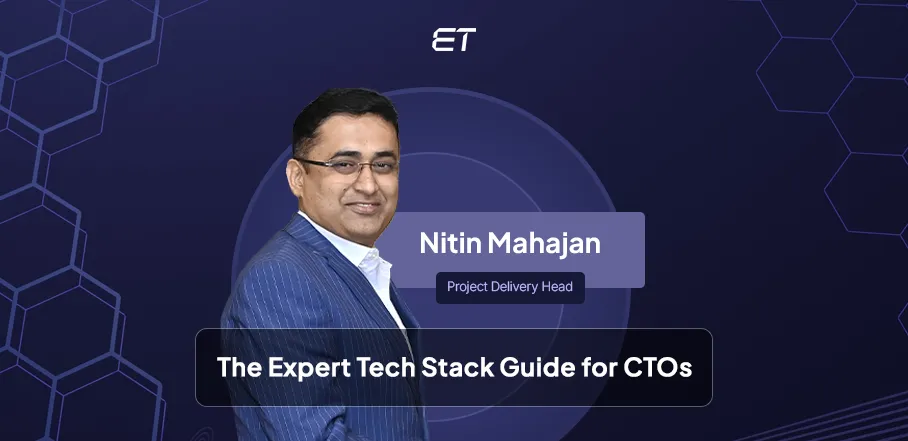
What CTOs Should Know About Building a Future-proof Tech Stack?
We’ve seen numerous tech trends in our 20+ years of navigating software development projects. Some fizzle out; others reshape entire industries. But one truth remains constant: a company’s tech stack is the backbone of its digital identity.
For CTOs in 2025, building a future-proof tech stack isn’t just a strategy. In fact, it’s a mandate for sustainability. The stakes are higher than ever as US businesses face relentless pressure to deliver faster, smarter, and more secure solutions. You know the reasons – evolving customer demands, regulatory shifts, and a hyper-competitive market.
Building a future-ready tech stack isn’t about chasing the latest popular framework or jumping on every hyped-up tool. It’s about making choices that align with your business goals. In this blog, we’ll break down what CTOs like you need to know to architect a tech stack that sets the stage for long-term success. So, without any ado, let’s dive in!
Slash costs and boost agility with a future-ready stack.
What’s the Current State of Tech?
As we sit in 2025, US businesses are doubling down on technologies that promise efficiency, scalability, and resilience. Our conversations with peers and observations across the industry show a clear picture: companies aren’t just throwing money at tools. They’re investing in what delivers measurable ROI.

Statista states that global digital transformation spending is around USD 2.49 trillion. Clearly, tech is booming.
- Cloud infrastructure continues to dominate.
- Hybrid and multi-cloud setups lead the charge.
- AI and machine learning are table stakes.
- Cybersecurity spending is skyrocketing with a global revenue of USD 203 billion. This stat is hardly surprising given the relentless rise in breaches and compliance demands.
But it’s not just about refining the tried-and-true. Emerging technologies are reshaping what’s possible, and you need to know where to place your bets. Below, we’ve zeroed in on four game-changers that are already making waves.
Low-Code/No-Code Platforms
These tools aren’t just for startups anymore. Enterprises are leaning into low-code/no-code platforms to accelerate development cycles and empower non-technical teams. In 2025, they’re a lifeline for businesses facing talent shortages, letting you prototype and deploy solutions at breakneck speed without sacrificing quality.
Eager to cut development costs with low-code tricks? Check our expert options today.
Edge Computing
With IoT exploding and latency becoming a dealbreaker, edge computing is stepping up. In fact, the market size in this area can reach USD 350 billion by 2027.
Processing data closer to the source has become a necessity for real-time applications like autonomous systems and smart manufacturing. US industries, especially logistics and healthcare, are all in.
Quantum Computing (Early Adopters)
We’re not at full-scale quantum supremacy yet, but the early adopters are already experimenting. For CTOs in finance, pharma, or logistics, quantum’s potential to crack complex optimization problems is worth watching. It’s a long-term play, but the groundwork starts now.
AI-Driven DevOps
AI isn’t just for end products. It’s transforming how we build them. AI-driven DevOps tools automate code reviews, predict deployment failures, and optimize CI/CD pipelines. In 2025, this is how you keep your teams lean and your releases flawless.
The takeaway?
Businesses today are balancing immediate wins with bold bets on tomorrow. But you need a foundation that ties it all together. That’s where the core principles of a future-proof stack come in.
Want to streamline DevOps with AI power? Unpack our essential insights now.
The Core Principles of a Future-Proof Tech Stack
Over two decades of serving global clients, we’ve seen stacks collapse under rigid choices and soar with smart ones. For 2025 and beyond, four principles stand out as non-negotiable for US businesses aiming to thrive in this fast-moving landscape:
- Adaptability
- Scalability
- Security
- Team Alignment
Sam Altman said an apt thing about Adaptability.

Now, let’s move on to understanding each principle in brief.
Adaptability: Stay Nimble, Not Locked In
Tech moves fast. So, your stack needs to keep pace. That means favoring modular architectures and interoperable tools over monolithic systems.
We’ve watched companies sink millions into platforms they couldn’t pivot away from when the market shifted.
The best strategy? Opt for solutions with open APIs and vendor-agnostic designs. Adaptability isn’t just about seizing any potential opportunity.
Scalability: Grow Without the Growing Pains
Your stack should handle a spike in users or data as smoothly as it runs on day one. Cloud-native designs and microservices are proven ways to scale efficiently.
Most businesses falter because their legacy systems choke under pressure. So, plan for growth upfront, and you’ll save yourself a costly rebuild later.
Security: Build Trust, Not Headlines
Breaches cost US companies billions of dollars. According to IBM, the average data breach cost was USD 4.88 million in 2024. This number proves one thing – security isn’t optional.
Embed it into your stack from the ground up. Think of:
- Encrypted data pipelines
- Zero-trust authentication
- Regular audits
We’ve learned the hard way that a single weak link can unravel years of progress. Protect your customers, and you protect your reputation.
Team Alignment: Tools Your People Can Master
A tech stack’s only as good as the team running it. Pick technologies that match your developers’ skills.
We’ve seen brilliant tools flop because no one could use them effectively. Balance cutting-edge with practical, and invest in training. A cohesive team turns a good stack into a great one.
All in all, build on these principles to lead the pack. Next, let’s talk about putting this into action.
How to Put Your Tech Stack into Action in 2025?
Knowing the principles is one thing. But making them real is where the rubber meets the road. Over decades of guiding teams and clients, we’ve honed a playbook for turning vision into execution.
For US businesses in 2025, here’s how we recommend CTOs like you bring a future-proof tech stack to life:
1. Recognize your needs
2. Prioritize and plan
3. Prepare the team
4. Test and iterate
For brief explanation, you can scroll ahead.
Step 1: Assess What You’ve Got

Start with a hard look at your current stack.
We’ve seen too many teams skip this step and end up patching holes they didn’t know existed. Audit your tools, infrastructure, and workflows. Then, map them against adaptability, scalability, security, and team alignment.
Ask the following questions:
- What’s holding us back?
- Where are we exposed?
A clear baseline lets you prioritize without guesswork.
Step 2: Prioritize and Phase

You can’t overhaul everything overnight. We’ve learned that phased rollouts beat big-bang rewrites every time.
So, rank your needs or set preferences.
- Is it security tightening to dodge those costly breaches?
- Scalability to handle growth?
Pick one or two solutions, pilot them, and scale up. This tactic keeps momentum high and disruption low.
Step 3: Rally the Team

A stack shift isn’t just tech, it’s people.
We’ve watched brilliant plans fail because the team wasn’t on board. Bring your developers into the fold early. Then, align tools with their strengths, fill skill gaps with targeted training, and set clear goals. A unified crew turns a stack from functional to unstoppable.
Step 4: Test and Iterate

Don’t bet on unproven choices. POCs (proofs of concept) come in more than handy here. Test new techs like low-code platforms, edge setups, or any other tools in the queue.
Monitor performance, gather feedback, and tweak as you go. Iteration beats perfection in such cases. So, start small, move fast, and build a stack that doesn’t evolves with tomorrow.
Our Suggestions for Your Future-Proof Tech Stack
Drawing from the latest insights (Stack Overflow Developer Survey), we suggest a tech stack that aligns with 2025’s demands. These picks aren’t just trendy; they’re tried-and-tested, widely admired, and can meet your business needs.
Here’s what we’d put on your radar for clarity.
| Category | Recommendation | Why it Works? | Survey Insight |
| Languages | JavaScript, Python, Rust | JavaScript powers web scalability, Python excels in AI and prototyping, Rust nails performance and security. | 62.3% use JS, 51% use Python, Rust most admired (83%). |
| Databases | PostgreSQL | Robust, open-source, scales from analytics to high-transaction apps with ease. | 49% usage, up from 33% in 2018. |
| Tools | Docker, VS Code | Docker streamlines DevOps with containers, VS Code boosts productivity with integrations. | 59% use Docker, VS Code tops IDEs. |
| Emerging Picks | Svelte, Raspberry Pi | Svelte delivers lightweight UIs, Raspberry Pi enables cheap IoT/edge experiments. | 73% admire Svelte, 39% use Raspberry Pi. |
To Wrap Up
In this blog, we’ve walked through the current technology landscape, spotlighted emerging tech, and laid out principles and picks that stand up to 2025’s demands.
From adaptable architectures to scalable tools like PostgreSQL and Docker, we’ve seen how the right choices drive efficiency, cut risks, and keep customers coming back. Stack Overflow’s survey backs it up profoundly. Long story short, a future-proof stack doesn’t just fuel your resources, it’s fewer breaches costing millions, faster rollouts beating competitors to market, and teams that innovate instead of firefight.
So, take the next step. Assess, prioritize, and build.
Cut breaches and accelerate growth with a rock-solid stack.
Frequently Asked Questions
1. What makes a tech stack future-proof in 2025?
Adaptability, scalability, security, and team fit make a tech stack future-proof. Stacks thrive when they include AI or edge computing, scale without crashing, lock down risks, and match your team’s skills.
2. Which tools should CTOs prioritize now?
According to the Stack Overflow 2024 Survey, PostgreSQL, Docker, and JavaScript lead in the tech stack domain. We’d add Rust for security-critical apps to this list.
3. How do we start upgrading our technology stack?
First, assess your current setup. Next, pinpoint gaps (e.g., scalability), and phase in fixes. Persistent testing and implementation are crucial for your success.





